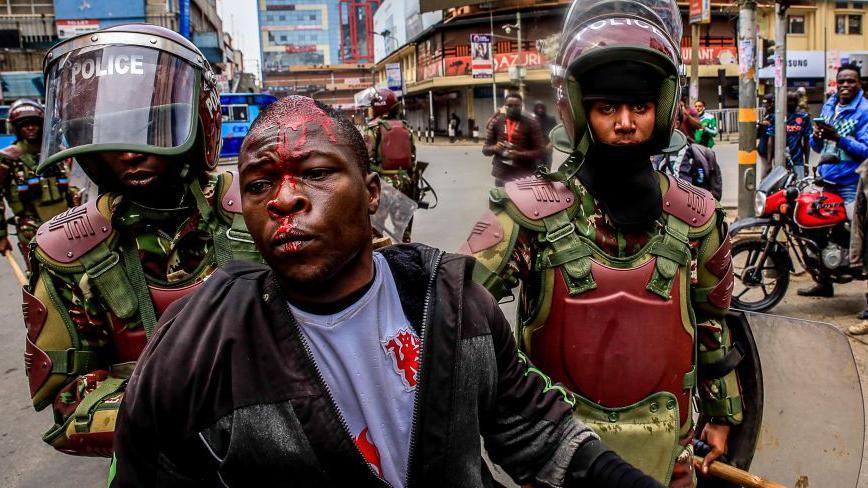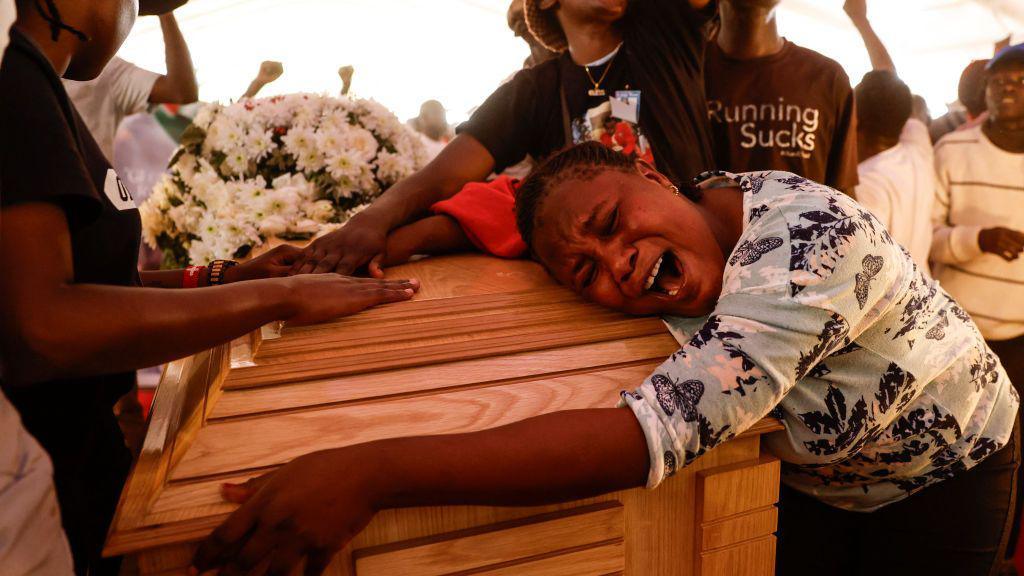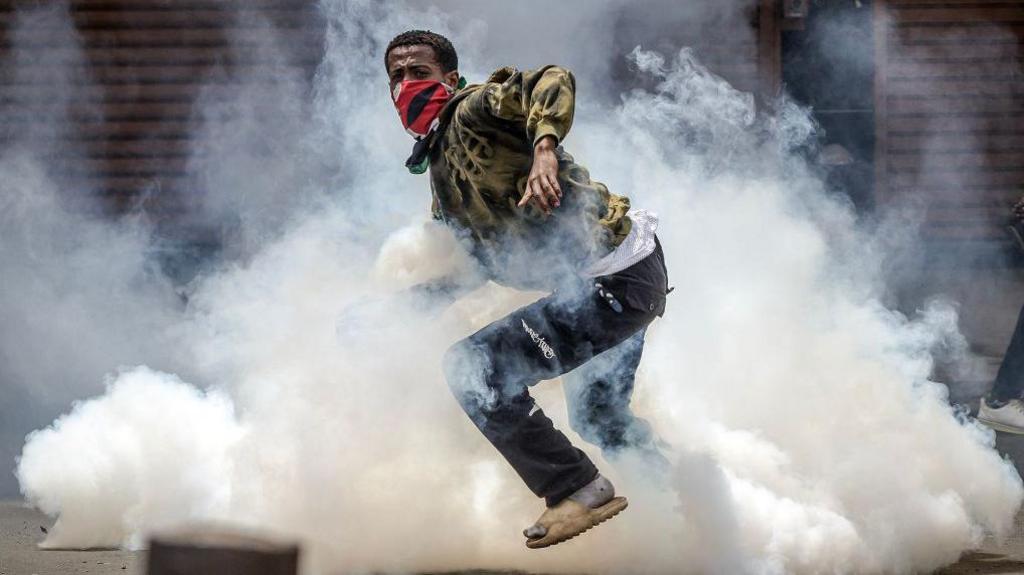Batons, tear gas, live fire - Kenyans face police brutality

Protesters have complained about the way they were treated by the police
- Published
The recent wave of the deaths of dozens of people in Kenya, as police cracked down on protests countrywide, began with the shooting of 30-year-old Rex Masai.
The killings have further eroded what little trust there was in the police to maintain order. And as a new series of protests is about to begin, there are concerns over how the security forces will respond.
WARNING: This piece contains descriptions of violence that some readers may find distressing.
20 June saw demonstrations against a finance bill that was going to raise new taxes break out for a second time. The previous day of action, two days earlier, had been without major incidents, but as sun set on that Thursday something changed in the heart of the capital, Nairobi.
The protesters became more defiant. Police officers switched from using water cannon and tear gas to firing live bullets.
Mr Masai got caught at the wrong end of that. He was shot in the thigh and bled to death.
“His blood was all over my hands,” says his friend, Ian Njuguna, who rushed to try and help him when he fell to the ground.
But as he and another friend tried to carry him to a nearby hospital “the officer tear-gassed us [as] we were carrying our dying friend”.
“We were frantically trying to speak to him, pleading with him not to leave us.”
At least four police officers so far are to face prosecution for shooting and killing protesters over the last four weeks, amid rising calls for justice for victims of the alleged excessive use of force.
But the investigations have been tricky.
“We have encountered non-cooperation from the police and to a certain level some intimidation even to our officers,” John Waiganjo, a commissioner from the Independent Policing Oversight Authority (IPOA), told the BBC.

Rex Masai bled to death after being hit in the thigh
But the investigation into the killing of Mr Masai has not yet resulted in the start of a prosecution, as investigators seek to gather more evidence and record statements.
Mr Waiganjo did not comment on this specific case but explained that when investigating injury or death the IPOA needs information on where the guns involved were from and the identity of the officers allegedly involved.
The BBC has verified a video filmed around the same time and likely the same place that Mr Masai was killed, showing what appears to be a plain-clothes police officer shooting at a crowd of protesters who were fleeing along a street.
Mr Njuguna says he thought his friend was profiled by the officer who shot him because he had dreadlocks.
“He was accused of stealing a phone. There was a shop that was looted. So, they thought he was one of the looters, so they shot him – because of what? Dreadlocks," he tells the BBC, sounding angry and frustrated.
On the night he was killed, Mr Masai’s family says the doctor who pronounced him dead confirmed there was a bullet lodged in his thigh, with a wound visible on one side but no exit wound on the other.
“When I got to [where he died], I asked the medics to uncover my son’s body,” his mother, Gillian Munyao, told the BBC a day after the incident. She saw where the bullet had entered his leg.
After the autopsy, the family and friends of Mr Masai were shocked to learn that bullet could not be found in his body. They suspected that it was removed at some point.
When the BBC told Mr Waiganjo of the allegation of a lack of physical evidence, he was not surprised, given the IPOA’s own challenges securing items to aid their investigations.
This can derail the quest for justice despite the IPOA’s powers to compel institutions to hand over any vital information.
The BBC contacted acting head of police Douglas Kiricho for a response to the allegations of obstructing investigations and of using excessive force against protesters.
While he acknowledged the request and instructed the police spokesperson to respond to our specific questions, no response had been received by the time of publishing this story despite multiple reminders.

The finance bill was dropped by President William Ruto but the protests have continued
This criticism of the police comes as Kenyan officers are deployed to Haiti, where they are leading an international mission to tackle the country's powerful gangs.
For many Kenyans, the conduct of police at home has left them with little faith in the system.
It is unsurprising that the IPOA says it has struggled to get witnesses to record statements in Mr Masai’s case or the others, as people are often scared to come forward. The IPOA is using allegations shared on social media of killings, arbitrary arrests and abductions to initiate investigations.
Looking across the weeks of protests as a whole, BBC Verify has found dozens of videos which appear to show what activists and the police oversight body say would amount to excessive use of force and violations by the police as they quelled the protests.
The BBC has managed to verify the locations and time the incidents took place by comparing landmarks we can see in the video with Google Street View imagery and satellite maps, local media reporting and other videos showing the same events.
The videos range from shooting at unarmed protesters, beatings with batons, attacks on people offering first aid, attacks on journalists and abductions.
In one video filmed along next to the Parliament buildings a protester is seen walking towards the police with his arms raised. Moments later, shots ring out.
We later see him being bundled into the back of a police vehicle, with wounds on both legs, screaming.
“I haven’t done anything, I haven’t burned any vehicle... they have shot me for nothing,” he says, as he shows the wounds on his legs.
“It is not justified to use live fire or even rubber bullets on people who are unarmed, and essentially not confronting the police violently,” says Irungu Houghton, the executive director of the Kenyan branch of rights group Amnesty International.
He argues that there is a clear legal framework for policing in the country. “You can't go more than one page without reading the words human rights and service to citizens."
We won’t take revenge. We leave it to God"

But he reckons the problem is deep-rooted in the system: “Rather than de-escalating conversations, or essentially facilitating peaceful protests, what we've seen is an attempt to try and block peaceful protests. And that's where things break down.”
He argues that policing can work if the leadership is clear that the role of the police is to de-escalate tensions.
“If demonstrations are peaceful, the police are not supposed to use any tear gas canisters or water cannons, or even live bullets,” Mr Waiganjo says.
Their role is to guide protesters along an agreed-on path, and “can only use firearms when a person’s life is in danger”.
Asked if she was confident justice would be served, Mr Masai’s mother said: “You know how government works here but let me trust for the best.”
“I’d say to the police, in the upcoming protests, they are parents just as we are. The pain we feel should be theirs. We won’t take revenge. We leave it to God.”
More BBC stories on the protests in Kenya:

Go to BBCAfrica.com, external for more news from the African continent.
Follow us on Twitter @BBCAfrica, external, on Facebook at BBC Africa, external or on Instagram at bbcafrica, external